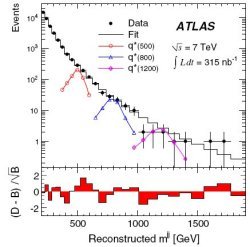
Data from ATLAS are the black dots that follow a relatively smooth curve. Excited quarks would appear as bumps that are illustrated by the three coloured curves. (Courtesy: PRL)
By Hamish Johnston
Unlike most people, particle physicists can get very excited about seeing absolutely nothing.
Indeed, one of the world’s most prestigious journals has published a letter from the ATLAS collaboration at the Large Hadron Collider (LHC) about how the multibillion-euro facility has found no evidence for an “excited quark” or any other unexpected particles.
And furthermore, it’s done a much better job at not finding an excited quark than its less energetic competitor, Tevatron at Fermilab in the US.
In the Standard Model of particle physics, quarks are fundamental particles. This means that they have no internal structure and therefore no excited states. By failing to find excited quarks (or other surprise particles) at masses up to 1.26 TeV, the ATLAS team have provided invaluable guidance to physicists who are developing theories beyond the Standard Model.
Tevatron had previously excluded excited quarks to about 0.87 TeV, which required 3500 times more data than the ATLAS measurement. This performance bodes well, and we can look forward to the LHC not finding many more particles – and who knows, it might even manage to find a new particle or two.
But what’s really incredible about this paper in Physical Review Letters is the author list, which begins with G Aad and ends with V Zutshi. Normally, letters are restricted to four pages, but this one stretches to 19 pages to include all the authors and their organizations. I gave up counting authors (I think there are about 3000), but there are 177 organizations listed.
Sadly, 19 authors passed away before seeing ATLAS’s first publication of results in PRL.
The letter is published at Phys. Rev. Lett. 105 161801.



